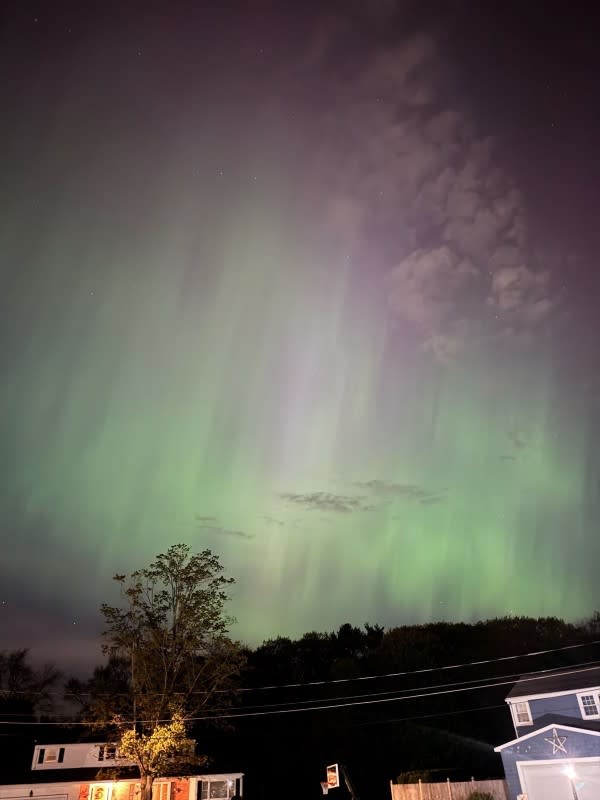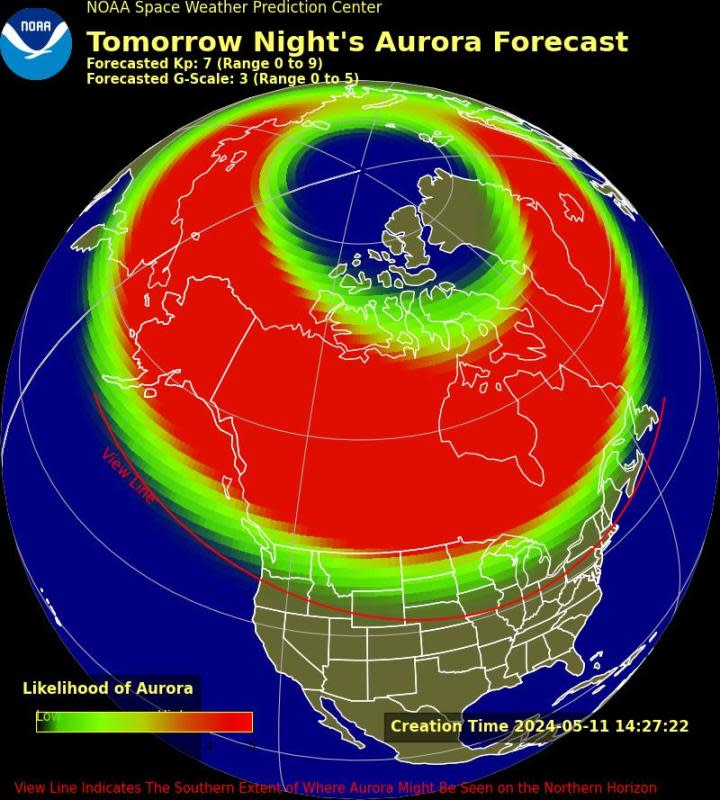Where and How to Watch the Northern Lights in the U.S. Tonight

This may sound like science fiction, but this is no movie. Dancing ribbons of light, scientifically known as aurora and often called the Northern Lights, are painting the night sky across the U.S. and around the world.
Considered the holy grail of skywatching, people often travel thousands of miles to see this rare phenomenon, typically only visible in the winter months and near the earth's magnetic poles. Think Scandinavia, Iceland, Finland, the far north in Alaska.
But a rare solar storm is painting the skies across wide swaths of the U.S. with bold hues of green, purple and red. The Northern Lights are expected to beam as far south as Northern California to Texas to North Carolina.
"This is an unusual and potentially historic event," Clinton Wallace, director of the National Oceanic and Atmospheric Administration's Space Weather Prediction Center, said in a release.
What's causing this rare light show? NOAA space weather forecasters have observed at least seven coronal mass ejections (CMEs) from the sun.
CMEs are explosions of plasma and magnetic fields from the sun’s corona. This epic blast of solar wind can cause geomagnetic storms when they are directed at Earth. In other words, explosions of particles from the sun have been blasted into space.
NOAA says this mass eruption of solar material is very rare. The last time an extreme geomagnetic storm hit earth in such a massive way was in 2003.
The Sun is super active right now! ?? ?? ??
The video below shows a series of flares that erupted over the past seven days… not counting another X-class flare that happened this morning! pic.twitter.com/O5jwUBmMDT— NASA Sun & Space (@NASASun) May 10, 2024
Storms of this nature can potentially disrupt communication, the electric power grid, navigation and radio and satellite operations.
But they can also provide beautiful light shows across the night sky.
Want to get a peek at the Northern Lights without booking a flight to Iceland? Wait until the sky is as dark as possible and step outside.
The Northern Lights are expected to be visible until Sunday, May 12. Here are some tips for viewing this spectacular light show for yourself.
How to see the Northern Lights tonight?
The best places to see the Northern Lights are outside cities and away from bright lights. Optimal viewing sites will also have clear skies. Western states along the coast are expected to have cloudless skies and have perfect viewing conditions.
NOAA predicts the auroras to be visible over much of the northern half of the country and maybe as far south as Alabama to northern California.
The CMEs were anticipated to merge and arrive at earth by late on May 10 or early on May 11 and continue until the evening on May 12.
Skies were cloudy and rainy on Friday night in New York City but there have been reports of seeing the Northern Lights in Atlanta; Buffalo, NY; Dallas; Pittsburgh; Nashville; Michigan; Charlotte, NC and more.

How long do Northern Lights last?
Northern lights usually dance in the sky for a few minutes and then slither off. Sometimes a display can last around 15 to 30 minutes or even a few hours. But that is unusual.
Related: When Is The Next Blue Moon?
What time can we see the Northern Lights?
The National Oceanic and Atmospheric Administration's (NOAA) Space Weather Prediction Center says that the optimal viewing time is between 10 p.m. and 2 a.m. local time. Parade editors in Middle Tennessee got a nice light show from 9-10 p.m. CT Friday night.
Light shows are expected to persist through Sunday, May 12.
What direction to look for Northern Lights?
According to the NOAA, face the magnetic poles. In the U.S., that means you should look to the north. The top of a hill with a clear view toward the north should have a good chance of seeing the Northern Lights.

Northern lights or aurora borealis illuminate the night sky over a camper's tent north of San Francisco in Middletown, California
JOSH EDELSON/AFP via Getty Images
View the 9 images of this gallery on the original article
What states can see Northern Lights tonight?
It might be easier to make a list of states where the aurora borealis will not be visible. Whether or not you can see the Northern Lights tonight will depend more on weather conditions than presence of the space phenomenon. So far, the at least parts of the following states have reported seeing aurora borealis during this solar storm. Again, it will mostly depend on weather in your area.
Arizona
California
Florida
Georgia
Indiana
Massachusetts
Nebraska
New York
North Carolina
Ohio
Oklahoma
Oregon
Pennsylvania
Tennessee
Texas
What is the aurora?
According to NOAA, and this gets fairly technical: "Aurora is the name given to the glow or light produced when electrons from space flow down Earth’s magnetic field and collide with atoms and molecules of the upper atmosphere in a ring or oval centered on the magnetic pole of Earth. The collisions produce light much like how electrons flowing through gas in a neon light collide with neon and other gasses to produce different colored light bulbs."
Why is it called aurora?
The word Aurora was first used by Galileo and comes from Latin and is the name of the goddess of dawn. The word Borealis comes from the Latin word boreal which means “northern” or “from the north.”
Related: 125 Cosmically Cool Baby Names Meaning Moon for Boys and Girls
How to photograph the Northern Lights?
You don't need fancy equipment or a special camera to photograph the Northern Lights. Your smartphone should allow you to capture them.
Here are some tips from Visit Iceland:
No Flash: Models like the iPhone 11 Pro and newer have Night mode. Use it to adjust your exposure time (around 10-15 seconds) to capture the aurora's dance.
Apps: If your default camera lacks manual controls, consider apps like Northern Lights Photo Taker, NightCap Camera, ProCamera, and Slow Shutter for iOS. For Android, ProCam X Lite is a good choice.
Screen Brightness: Dim your screen. A bright screen can hinder your night vision and may disturb others who are not so enthusiastic about your bright screen.
Is there a Northern Lights visibility map?
Hoping to catch a glimpse of the Northern Lights? NOAA distributed this Northern Lights visibility prediction map. But viewers much further south are reporting seeing auroras in their areas. See the full map and description on the NOAA site.

NOAA
Related: Celebrate the Official Start of Summer With These 50 Summer Solstice Quotes
